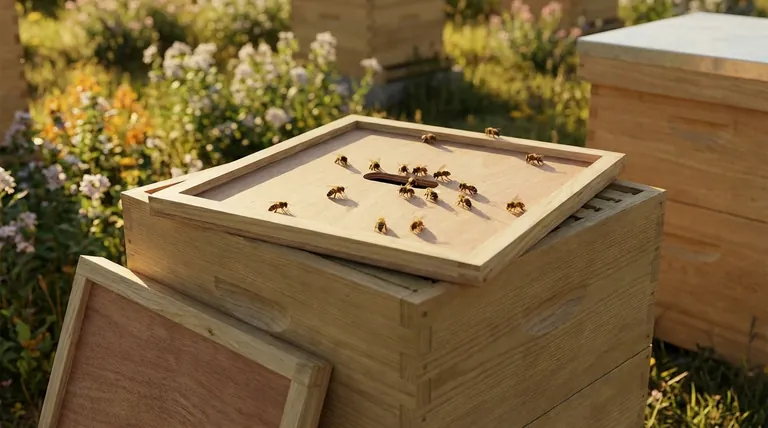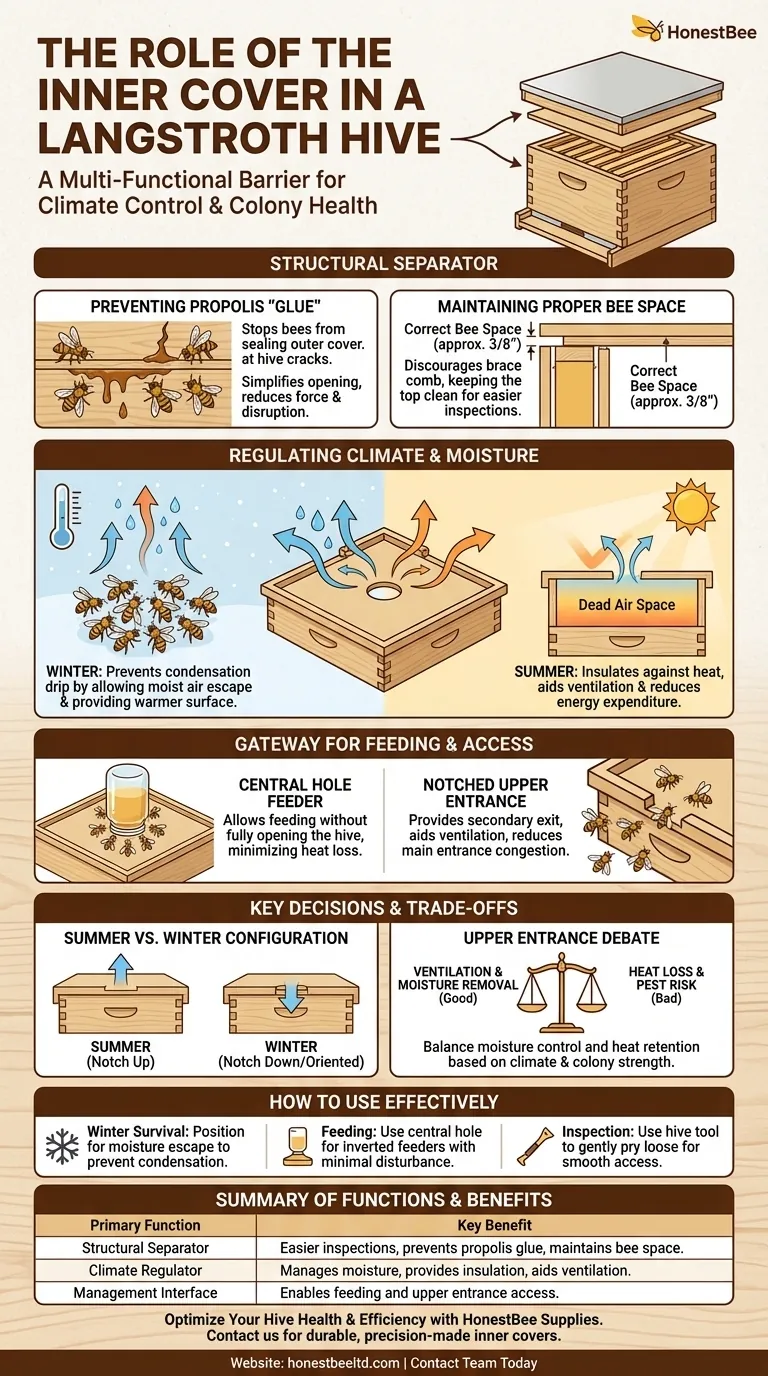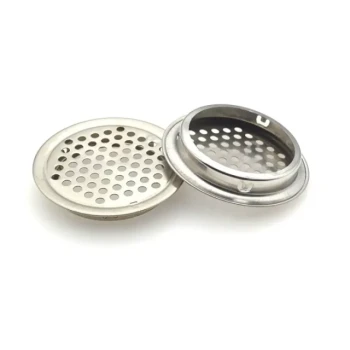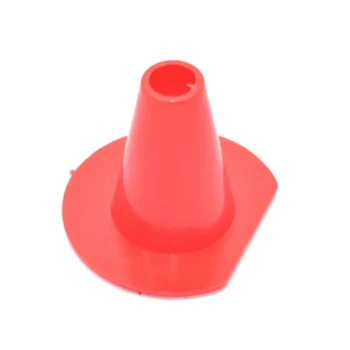In short, the inner cover of a Langstroth hive is a multi-functional barrier that sits between the top hive box and the outer telescoping cover. Its primary roles are to prevent bees from sealing the outer cover with propolis, provide crucial insulation, and help regulate moisture and airflow within the hive.
The inner cover is not just a secondary lid; it is the hive's climate control system. It creates a vital buffer zone that gives the beekeeper control over ventilation, temperature, and feeding access, making hive management easier and promoting colony health.

The Inner Cover as a Structural Separator
The most immediate benefit of the inner cover is physical. It simplifies the process of opening and inspecting the hive by creating a clean separation between the bees' living space and the hive's final outer protection.
Preventing Propolis "Glue"
Bees use a sticky resin called propolis to seal every crack and gap inside their hive. Without an inner cover, they would firmly "glue" the outer cover directly to the top box.
This makes opening the hive extremely difficult, requiring significant force that can jar the frames, damage equipment, and aggravate the colony. The inner cover provides a predictable, smooth surface to break this seal.
Maintaining Proper Bee Space
The inner cover is designed to maintain the correct "bee space"—a gap of about 3/8 of an inch—between the top of the frames and the cover itself.
This specific spacing discourages bees from building unwanted brace comb in this area, keeping the top of the hive clean and making frame removal much easier during inspections.
Regulating the Hive's Internal Climate
A healthy colony must manage its internal temperature and humidity. The inner cover is a simple but brilliant tool that aids the bees in this constant effort.
Managing Moisture and Condensation
In cold weather, warm, moist air from the bees' cluster rises. When it hits a cold outer cover, it condenses into water droplets that can drip down onto the bees, chilling or killing them.
The inner cover creates a warmer surface that helps prevent this. The notched upper entrance also allows this moist air to escape, acting as a critical ventilation port.
Providing Critical Insulation
The gap between the inner cover and the outer cover creates a pocket of dead air space. This pocket serves as an excellent insulator.
In the summer, it buffers the colony from the intense heat of direct sunlight. In the winter, it helps the hive retain the heat generated by the cluster, reducing the amount of energy the bees must expend to stay warm.
The Gateway for Feeding and Access
Beyond its structural and environmental roles, the inner cover serves as an interface for managing the colony.
The Central Hole for Feeders
Most inner covers feature a central hole. This port is perfectly designed for placing an inverted jar or can feeder, allowing you to provide sugar syrup directly above the cluster without fully opening the hive.
This minimizes disruption and heat loss, which is especially important when feeding a weak or overwintering colony.
The Notched Upper Entrance
A small notch is cut into one of the rims of the inner cover. This provides an upper entrance for the bees. It aids in ventilation and gives bees a secondary exit point, which can reduce congestion at the main entrance during a heavy nectar flow.
Understanding the Trade-offs
While essential, the configuration of the inner cover involves some key decisions.
Summer vs. Winter Configuration
The notched rim has two positions. In summer, you typically place the inner cover with the notch facing up to create the upper entrance and maximize airflow.
In winter, some beekeepers flip it so the notch is down, creating a smaller ventilation gap. Others orient it to provide an escape route for moisture while preventing drafts.
The Upper Entrance Debate
An upper entrance is excellent for ventilation but can also allow heat to escape in the winter. It's a trade-off between moisture removal and heat retention that beekeepers must manage based on their specific climate and colony strength.
Potential for Pests
Any extra opening can be a potential entry point for pests like wax moths or small hive beetles, especially if the colony is not strong enough to defend the space. A strong colony will typically have no issue guarding a small upper entrance.
How to Use Your Inner Cover Effectively
Your approach should be dictated by the season and your management goals.
- If your primary focus is winter survival: Position the inner cover to allow moist air to escape via the upper notch, preventing deadly condensation inside the hive.
- If your primary focus is feeding a new or weak colony: Use the central hole to place an inverted feeder, providing essential nourishment with minimal disturbance.
- If your primary focus is a smooth hive inspection: Appreciate that the inner cover allows you to use a hive tool to gently pry it loose before exposing the entire colony.
Understanding this simple wooden board is a key step toward becoming a more effective and observant beekeeper.
Summary Table:
| Primary Function | Key Benefit |
|---|---|
| Structural Separator | Prevents bees from sealing the outer cover with propolis, making hive inspections easier. |
| Climate Regulator | Manages moisture and condensation, provides insulation, and aids in ventilation. |
| Management Interface | Features a central hole for feeding and a notched rim for an upper entrance. |
Ready to optimize your hive's health and your beekeeping efficiency?
The inner cover is a simple piece of equipment with a profound impact on your colony's success. At HONESTBEE, we supply durable, precision-made inner covers and other essential beekeeping supplies to commercial apiaries and equipment distributors. Our wholesale-focused operations ensure you get the reliable equipment you need to manage hive climate, prevent disease, and promote strong colonies.
Contact our team today to discuss your supply needs and learn how our products can support your beekeeping operations.
Visual Guide

Related Products
- Inner Beehive Cover for Beekeeping Bee Hive Inner Cover
- Professional Insulated Winter Hive Wrap for Beekeeping
- Long Langstroth Style Horizontal Top Bar Hive for Wholesale
- Professional Galvanized Hive Strap with Secure Locking Buckle for Beekeeping
- Stainless Steel Round Beehive Air Vents for Ventilation
People Also Ask
- What is the role of inner covers in insulated beehives? Master Moisture Control for a Healthy Colony
- What is the role of the inner cover in a beehive? Essential Climate Control for Hive Health
- How is the inner cover used to promote ventilation? Master Hive Climate Control for Healthy Bees
- Why might beekeepers use an inner cover under the telescoping outer cover? Simplify Hive Management & Protect Your Colony
- What is the purpose of the inner cover in a beehive? A Key to Hive Health & Easy Management



















